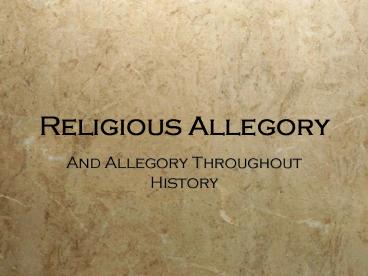Religious Allegory PowerPoint PPT Presentation
1 / 13
Title: Religious Allegory
1
Religious Allegory
- And Allegory Throughout History
2
What Is Allegory?
- 1. Description of a subject under the guise of
some other subject of aptly suggestive
resemblance. - 2. An instance of such description a figurative
sentence, discourse, or narrative, in which
properties and circumstances attributed to the
apparent subject really refer to the subject they
are meant to suggest an extended or continued
metaphor.
3
Uses of Allegory
- To allow a message to reach a broader audience
(such as commoners outside of the clergy) - To make otherwise complex concepts palatable
4
Dante
- The Divine Comedy details the three levels of the
afterlife in an allegorical manner.
5
Dante
- Well, if the subject of the whole work, taken
literally, is this subject The status of souls
after death, taken simply and not limited, it is
obvious that in this part such a status is the
subject, but restricted, that is, the status of
the blessed souls after death. And if the subject
of the whole work, taken allegorically, is man,
as he gains or loses merit by the exercise of his
freedom of will, being subject to the justice of
punishment or reward, it is obvious that in this
part the subject is restricted, namely, man, to
the extent that he is subject by merits to the
justice of punishment.
6
Pearl
- I never found her precious equal
- Fusing substantive allegory with a stylistic
metaphor the poem in its formatting is itself an
allegory.
7
Book of the City of Ladies
- Using allegory to make a case for women.
8
Plato
- Allegory of the Cave
The prisoners are chained to a wall in a cave and
can only see the shadows of things outside. The
philosopher is the one who can see that the
shadows are more than just shadows.
9
Ship of Fools
- Fools on a ship without a captain.
10
Aristotle
- Words spoken are symbols or signs (symbola) of
affections or impressions (pathemata) of the soul
(psyche) written words are the signs of words
spoken. - As writing, so also is speech not the same for
all races of men. - But the mental affections themselves, of which
these words are primarily signs (semeia), are the
same for the whole of mankind, as are also the
objects (pragmata) of which those affections are
representations or likenesses, images, copies
(homoiomata).
11
The Modern Allegory
- C.S. Lewis The Chronicles of Narnia
(1950-1956) - George Orwells Animal Farm (1945)
- Cormac McCarthys The Road (2006)
- J.K. Rowlings Harry Potter (1997-2007)
12
In Film
- Metropolis (1927)
- Casablanca (1942)
- 2001 A Space odyssey (1968)
- The Matrix (1999)
13
(No Transcript)

